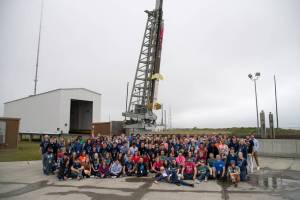NASA’s Wallops Flight Facility to Launch Student Experiments
More than 50 student and faculty teams are sending experiments into space as part of NASA’s RockOn and RockSat-C student flight programs. The annual student mission, “RockOn,” is scheduled to launch from Wallops Island, Virginia, on a Terrier-Improved Orion sounding rocket Thursday, June 20, with a launch window that opens at 5:30 a.m. EDT. An […]

4 min read
Preparations for Next Moonwalk Simulations Underway (and Underwater)
More than 50 student and faculty teams are sending experiments into space as part of NASA’s RockOn and RockSat-C student flight programs. The annual student mission, “RockOn,” is scheduled to launch from Wallops Island, Virginia, on a Terrier-Improved Orion sounding rocket Thursday, June 20, with a launch window that opens at 5:30 a.m. EDT.
An introduction to rocketry for college students
The RockOn workshop is an introductory flight opportunity for community college and university students. RockOn participants spend a week at NASA’s Wallops Flight Facility, where they are guided through the process of building and launching an experiment aboard a sounding rocket.
“RockOn provides students and faculty with authentic, hands-on experiences tied to an actual launch into space from a NASA facility,” said Chris Koehler, on contract with NASA as RockOn’s principal investigator. “These experiences are instrumental in the creation of our next STEM workforce.”
Unique & advanced experiments
In addition to the RockOn workshop experiments, the rocket will carry student team experiments from six different institutions as part of the RockSat-C program. The RockSat-C experiments are unique to each institution and were created off site.
RockSat-C “has been an incredible introduction into the world of NASA and how flight missions are built from start to finish,” said TJ Tomaszewski, student lead for the University of Delaware. “The project started as just a flicker of an idea in students’ minds. After countless hours of design, redesign, and coffee, the fact that we finished an experiment capable of going to space and capable of conducting valuable scientific research makes me so proud of my team and so excited for what’s possible next. Everybody dreams about space, and the fact that we’re going to launch still doesn’t feel real.”
RockSat-C participants include:
- Temple University, Philadelphia
Experiments will utilize X-ray spectrometry, muon detection, and magnetometry to explore the interplay among cosmic phenomena, such as X-rays, cosmic muons, and Earth’s magnetic field, while also quantifying atmospheric methane levels as a function of altitude.
- Southeastern Louisiana University, Hammond
The ION experiment aims to measure the plasma density in the ionosphere. This will be achieved by detecting the upper hybrid resonant frequency using an impedance probe mounted on the outside of the rocket and comparing the results to theoretical models. The secondary experiment, known as the ACC experiment, aims to record the rocket’s re-entry dynamics and measure acceleration in the x, y, and z directions.
- Old Dominion University, Norfolk, Virginia
The Monarch3D team will redesign and improve upon a pre-existing experiment from the previous year’s team that will print in suborbital space. This project uses a custom-built 3D printer made by students at Old Dominion.
- University of Delaware, Newark
Project UDIP-4 will measure the density and temperature of ionospheric electrons as a function of altitude and compare the quality of measurements obtained from different grounding methods. Additionally, the project focuses on developing and testing new CubeSat hardware in preparation for an orbital CubeSat mission named DAPPEr.
- Stevens Institute of Technology, Hoboken, New Jersey
The Atmospheric Inert Gas Retrieval project will develop a payload capable of demonstrating supersonic sample collection at predetermined altitudes and investigating the noble gas fractionation and contamination of the acquired samples. In addition, their payload will test the performance of inexpensive vibration damping materials by recording and isolating launch vibrations using 3D-printed components.
- Cubes in Space, Virginia Beach, Virginia
The Cubes in Space (CiS) project provides students aged 11 to 18 with a unique opportunity to conduct scientific and engineering experiments in space. CiS gives students hands-on experience and a deeper understanding of scientific and engineering principles, preparing them for more complex STEM studies and research in the future. Students develop and design their unique experiments to fit into clear, rigid plastic payload cubes, each about 1.5 inches on a side. Up to 80 of these unique student experiments are integrated into the nose cone of the rocket.
Watch the launch
The launch window for the mission is 5:30-9:30 a.m. EDT, Thursday June 20, with a backup day of June 21. The Wallops Visitor Center’s launch viewing area will open at 4:30 a.m. A livestream of the mission will begin 15 minutes before launch on the Wallops YouTube channel. Launch updates also are available via the Wallops Facebook page.
NASA’s Sounding Rocket Program is conducted at the agency’s Wallops Flight Facility, which is managed by NASA’s Goddard Space Flight Center in Greenbelt, Maryland. NASA’s Heliophysics Division manages the sounding rocket program for the agency.
Share
Details
Related Terms
What's Your Reaction?



















.jpg?#)







































